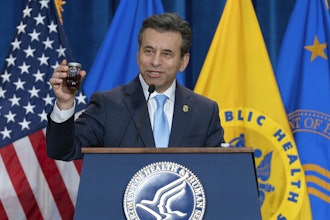RALEIGH, N.C. (AP) — A public water utility studied what it was serving to its 200,000 North Carolina customers and found it contained multiple unregulated industrial chemicals with uncertain health effects, including some substances that university researchers didn't know existed, legislators learned Thursday.
State lawmakers heard from chemists at the University of North Carolina at Wilmington and a top executive of the Wilmington area's main water utility as they try to figure out how the state should respond to rising concern about the prevalence of untested chemicals in drinking water.
The chemical GenX, previously found in drinking water served to Wilmington-area homes, is now in a range health officials think should be safe, Cape Fear Public Utility Authority Executive Director Jim Flechtner said. But GenX represents just 14 percent of a family of concerning compounds being investigated, while about 20 different related chemicals combined push the water question into unknown territory, he said.
The combined levels of compounds in water samples from one filtration plant in January were about 50 percent higher than the state's health goal for GenX, the utility's report to the General Assembly showed.
Officials could not immediately address their potential health risks.
"We don't know the combined health effects of these contaminants. We talk about GenX, but we know so many other compounds are in the river. We can't tell our customers what happens then those other compounds are added together and then consumed," Flechtner told members of a legislative committee investigating the impact of industrial chemicals in rivers and groundwater.
Local university researchers investigating water drawn from the Cape Fear River and delivered to consumers found several new perfluoroalkyl substances, or PFAS, "not previously reported in the scientific literature."
Rep. Jimmy Dixon, whose Duplin County district includes a long stretch of the river, said health concerns over GenX have been trumped up by lawyers looking for big paydays. Wilmington, Delaware-based Chemours Company makes GenX at a plant south of Fayetteville that employs about 900 workers.
"The water's clean folks. The water is safe," Dixon said.
GenX and other PFAS chemicals have been used for decades in food packaging, carpet, leather and apparel, textiles and plastics. Older versions of the chemical family can cause reproductive, liver, kidney and immunological problems in laboratory animals and have been phased out in the United States, the U.S. Environmental Protection Agency said.
A report released last week by Northeastern University's Social Science Environmental Health Research Institute at the Environmental Working Group found PFAS chemicals at sites in 22 states, and small amounts in tap water in North Carolina communities ranging from Greensboro to Lillington and Nashville.
Testing also has found the phased out PFAS chemicals in the lake supplying water to residents of Durham and Cary.
Legislators and Gov. Roy Cooper's health and environmental agency have been trying to figure out how to react since it became known last summer that GenX was in the Wilmington area's water supply. It's thought the chemical was carried by the river from the Chemours plant, about 100 miles (160 kilometers) upriver. The chemical was also carried away from the plant by rainwater and wound up in nearby private water wells. At least 115 homes were issued bottled water because GenX was detected at levels above the state health goal.
Lawmakers have so far resisted requests by Cooper to increase agency budgets even under rising concern over the chemicals in water supplies. Lawmakers failed in February to agree on an extra $2.3 million for the environmental agency.
Wilmington-area Rep. Ted Davis, R-New Hanover, said he's trying to negotiate a compromise that will win Senate passage for the funding.






















